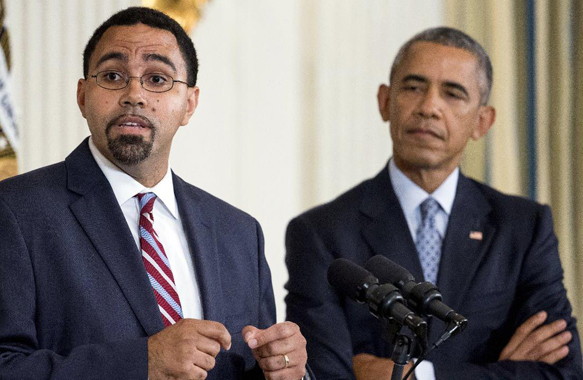Regardless of the abundant research on the ineffectiveness of merit pay, states continue to adopt policies that promote the plan. However, those same lawmakers who think money motivates, refuse to fund their own programs. Hence, failed and popular policies go quietly into the darkness from which they came. Consider the Texas story.
Photograph by Angela Peterson as seen in Journal Sentinel Hechinger Report; Seventh-grade history teacher Glen Allen holds a lively discussion at Milwaukee College Prep, one of a handful of private and charter schools that have adopted their own merit pay systems to drive student achievement. Allen came to the school after 11 years in Milwaukee Public Schools.
By Terrence Stutz | Originally Published at Dallas News. October 13, 2013
AUSTIN — It was the largest program of its type in the nation just a few years ago, hailed by Republican leaders as the wave of the future in education. But Texas’ once-vaunted teacher merit pay plan is no more.
What remained of the plan after massive funding cuts in 2011 has been converted this fall into a new state grant program that will pay for innovative education in a few dozen poor schools.
Nearly half of Texas teachers — about 180,000 educators — received bonuses under the incentive pay plan two years ago for higher test scores and student achievement. That was slashed after legislators made unprecedented funding cuts in education to ease a budget crunch. Funding for bonuses was cut 90 percent.
The program, known as the District Awards for Teacher Excellence, was kept alive the past two years in hopes that it could be resurrected in the future when the state’s revenue situation improved.
But the Legislature passed a measure this year to virtually kill it. The remaining funding, down to $24 million from a high of $392 million in the 2010-11 state budget, will be shifted into the newly named Educator Excellence Innovation Program.
Gov. Rick Perry, who led the original drive to implement merit pay for Texas teachers, signed the new bill into law this summer with little fanfare.
It was a sharp contrast to his enthusiastic support for merit pay a few years ago.
“Texas is going to take the national lead in rewarding educational excellence and attracting top-performing teachers to struggling campuses,” Perry promised in 2006.
The experiment was short-lived. And it will never be known whether the concept might have eventually showed results.
Texas teachers are sorry to see the bonus money gone, although many have long been skeptical of merit pay.
“Teachers would like to have the money, but there are lots of mixed emotions about giving it out based on how well kids perform on tests,” said Angela Davis, president of NEA-Dallas. “Some teachers wind up being punished for reasons beyond their control because not all students are good test takers.”
Still, she added, “Any time you do away with money that will help teachers, it’s not a good thing.”
Last bonus checks
The last bonus checks under the DATE program were distributed to teachers this fall. Roughly 18,000 qualified for bonuses based on performance in the 2012-13 school year.
Debbie Ratcliffe, a spokeswoman for the Texas Education Agency, emphasized that the merit pay plan was not discontinued because of any problems in the program.
“It was such a large pot of money that it became an easy target when the Legislature had to cut billions of dollars out of the budget,” she said. “It never really had a chance to work.”
A study of the Texas program by the National Center on Performance Incentives at Vanderbilt University found that students in schools with merit pay had greater test score gains than those in schools without merit pay. The schools also had less turnover among teachers.
About 295 school districts, including Dallas and 13 other North Texas districts, voluntarily participated in the DATE program when it was in full swing before the funding cutbacks of 2011.
Bonuses were based primarily on test scores of students. But each district developed its own criteria for distributing the merit pay money using state guidelines. In some cases, bonuses were given to deserving teachers across the district, while in other cases the money was directed at a select group of schools.
Average bonuses were much larger in select school plans. Where the bonuses went only to a group of schools in a district, the average payment was $3,344. For districtwide plans, the average payment was $1,361.
In most cases, larger bonuses produced better test scores and teacher retention.
“We can’t shed too many tears over the death of a program that we were always against,” said Clay Robison of the Texas State Teachers Association. “The Legislature needs to raise pay for all teachers before it resumes experiments on how to reward selective teachers.”
Moonlighting teachers
Robison cited the group’s survey of teachers that found 44 percent are moonlighting at second jobs this school year to make ends meet, slightly more than in 2010.
Former House Public Education Committee Chairman Rob Eissler, R-The Woodlands, authored the merit pay law. He still backs the idea.
“It was a good idea when we had more money, but that also made it among the most expendable when we had to start cutting” expenses, he said.
In place of the merit pay program — at a much reduced funding level — will be the new Educator Excellence Innovation Program. The program is still being developed and will award grants to schools with a high percentage of lower-income students beginning in the 2014-15 school year.
The program will be aimed at all teacher experience levels, including preparing new teachers to be successful in the classroom and providing veteran teachers with new career pathways. That could include becoming mentors for younger teachers, master teachers in certain subjects, instructional coaches or lead teachers in schools needing more expertise in some areas.
“We want this to be more a system of support for our teachers,” said Michele Moore, associate commissioner for educator leadership and quality at the education agency.
But Moore also said the program envisions some schools using “innovative compensation plans” to recruit and retain effective teachers.
Up to 40 campuses will be selected to receive grants in the first phase of the program. If they are successful, the program can be expanded to other schools.
“We hope to see some positive results that we can take to the next Legislature,” Moore said.
Follow Terrence Stutz on Twitter at @t_stutz.
AT A GLANCE
The Educator Excellence Innovation Program, which will replace teacher merit pay:
Will award grants to schools with a high percentage of poor students, starting next school year.
Is aimed at various levels of teacher experience and aims to provide incentive to develop new skills.
Will include up to 40 campuses in its first phase.












Leave A Comment